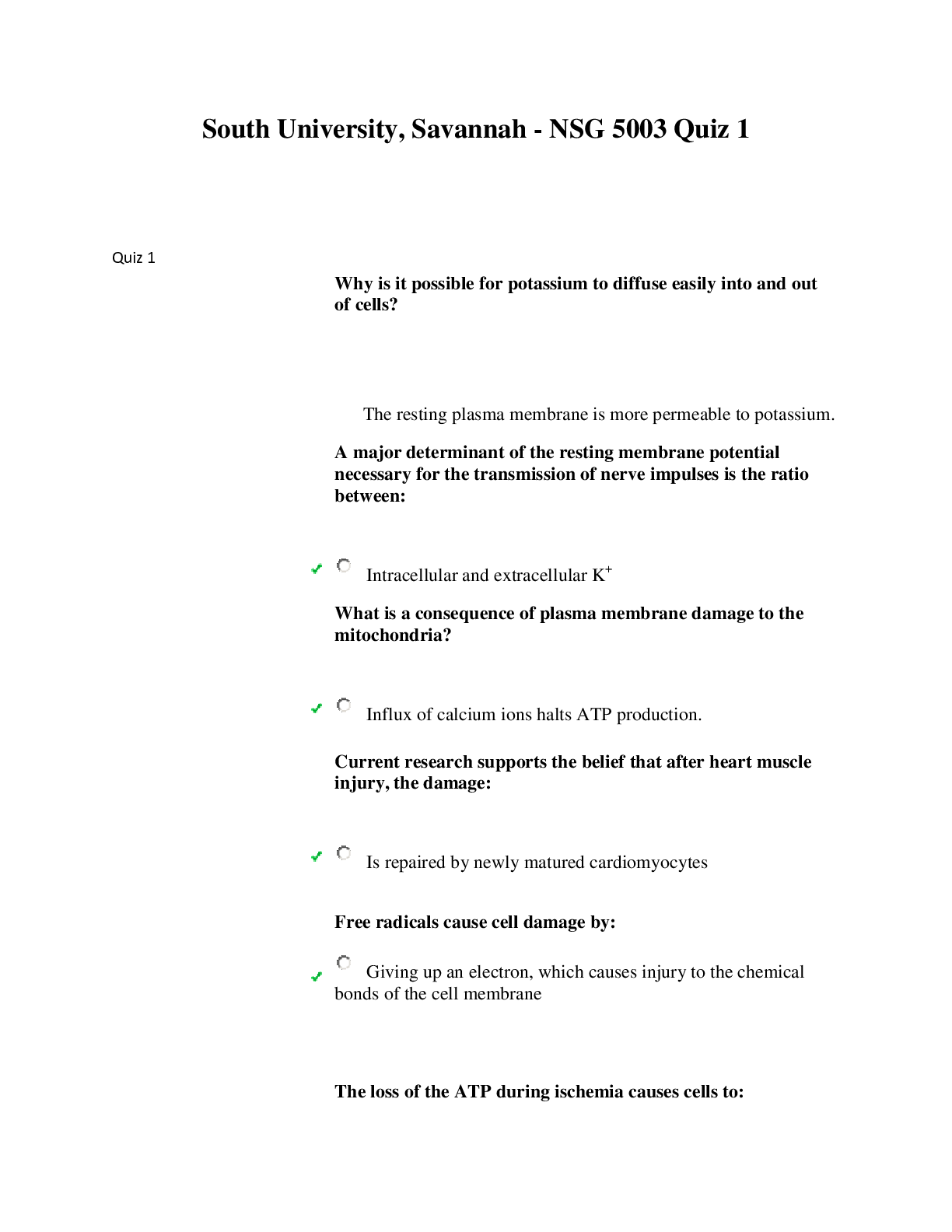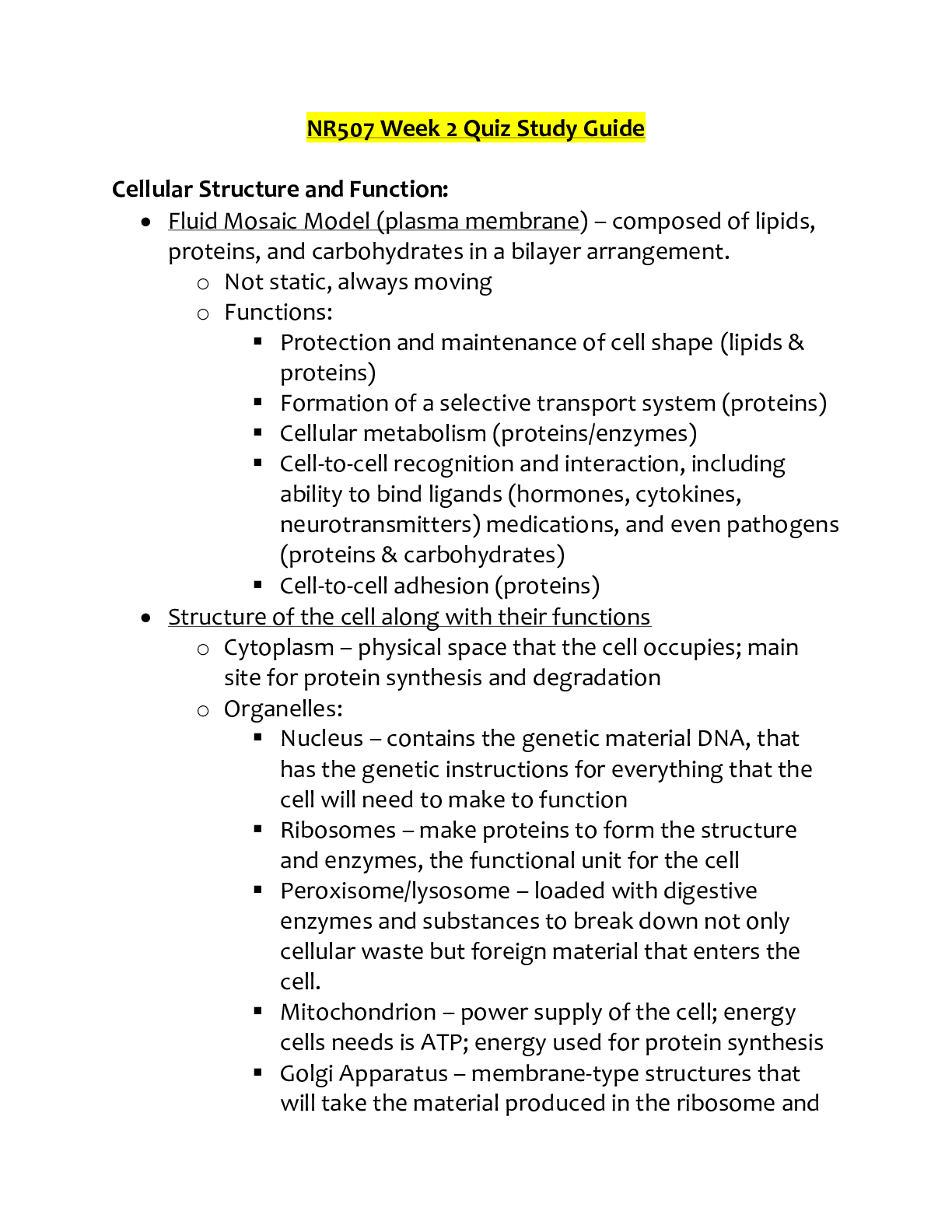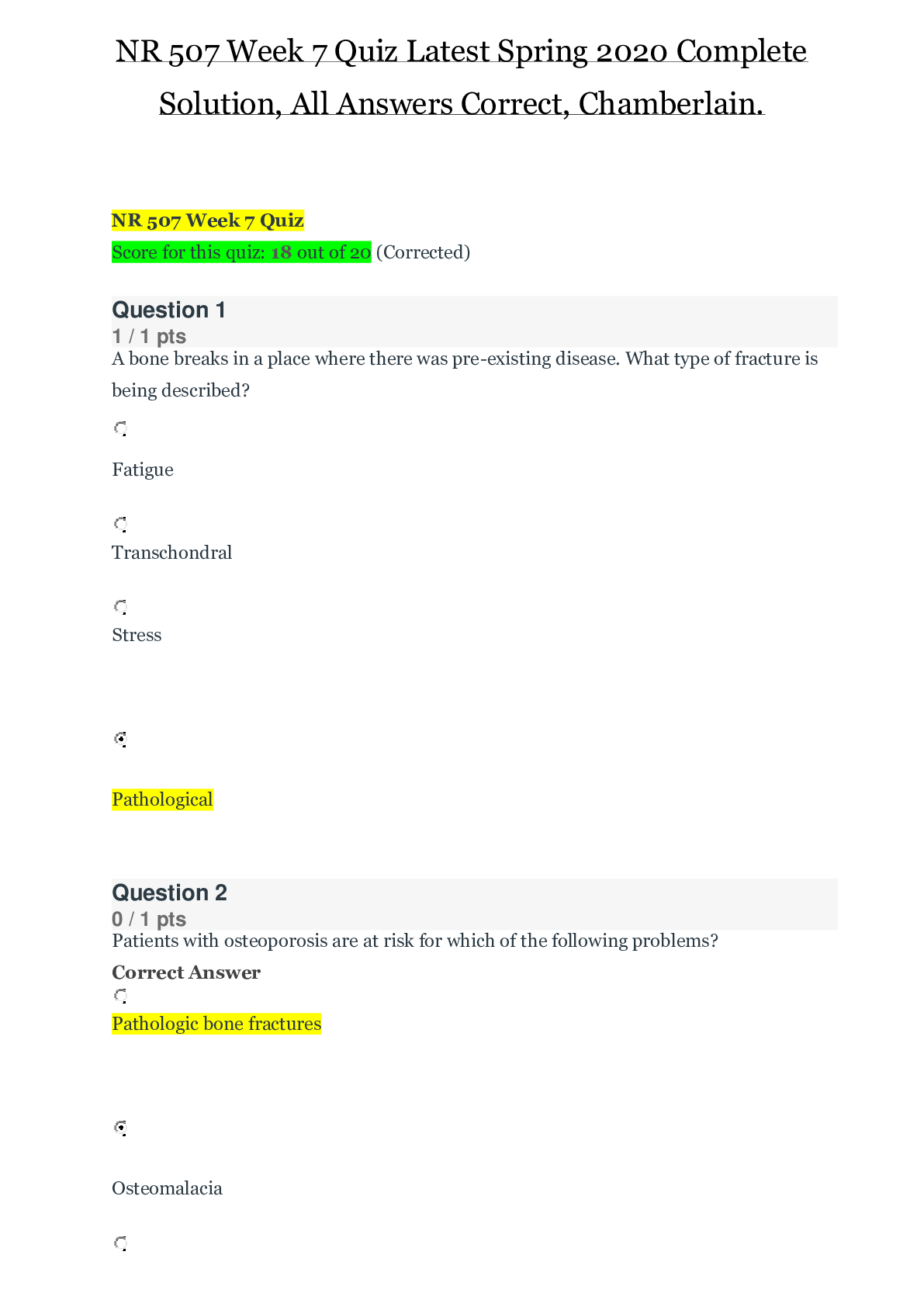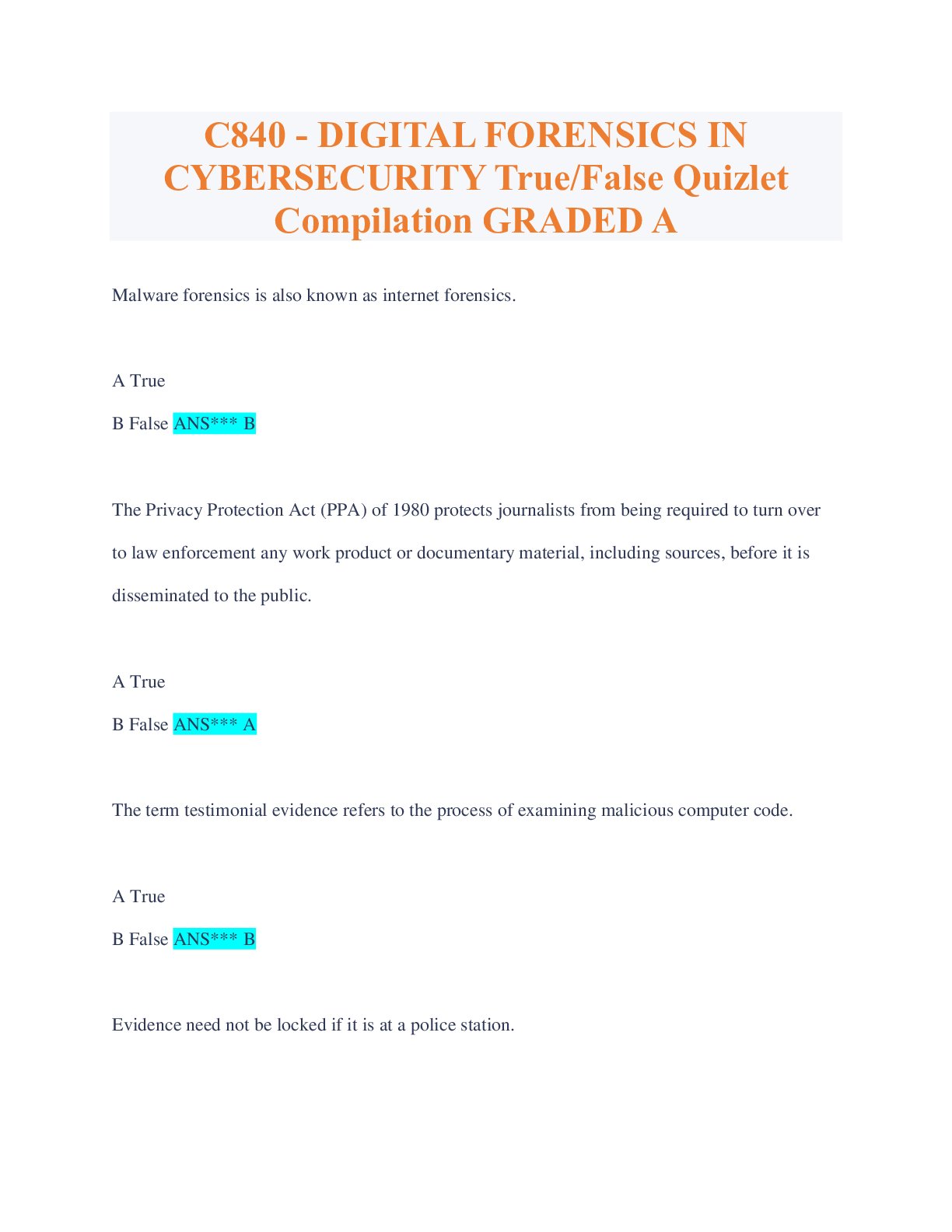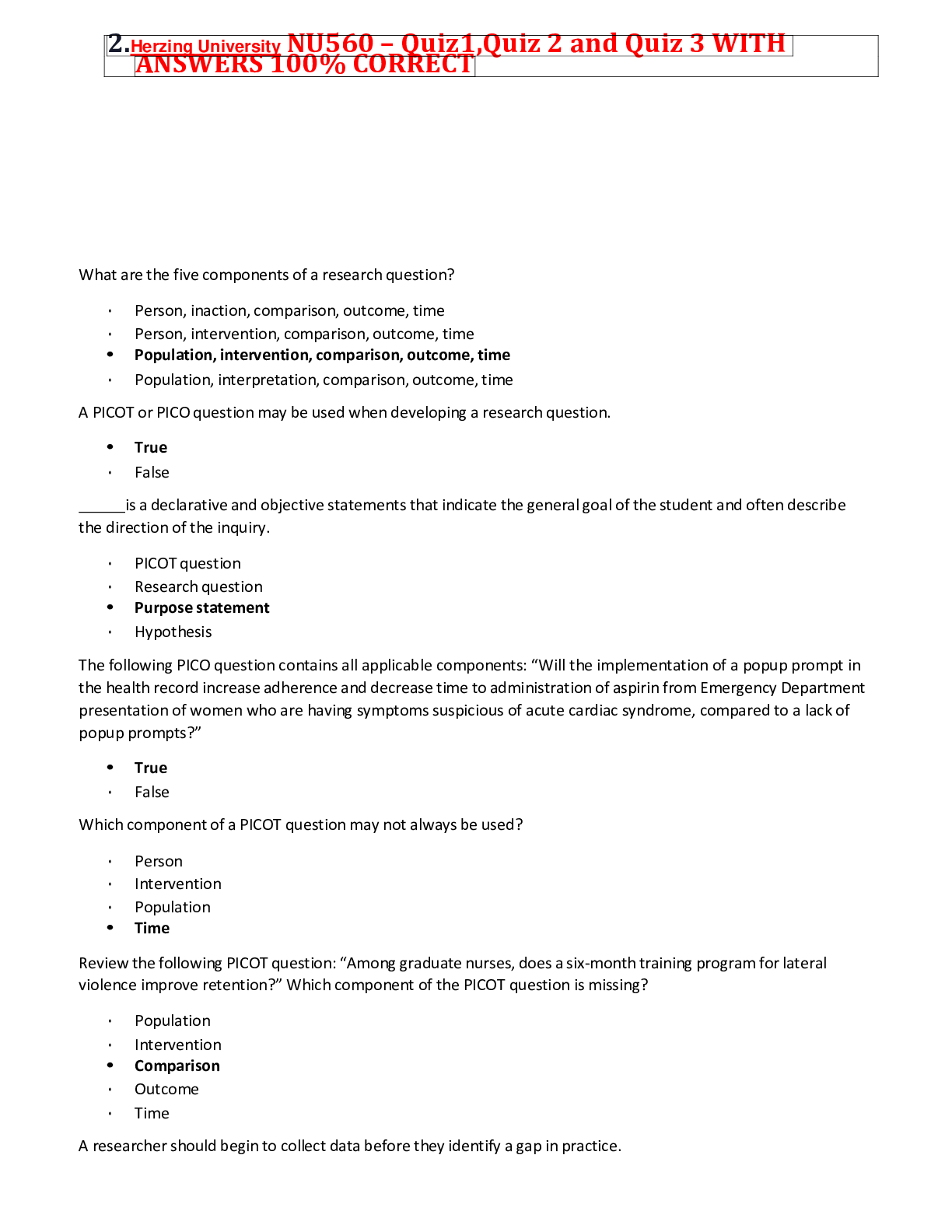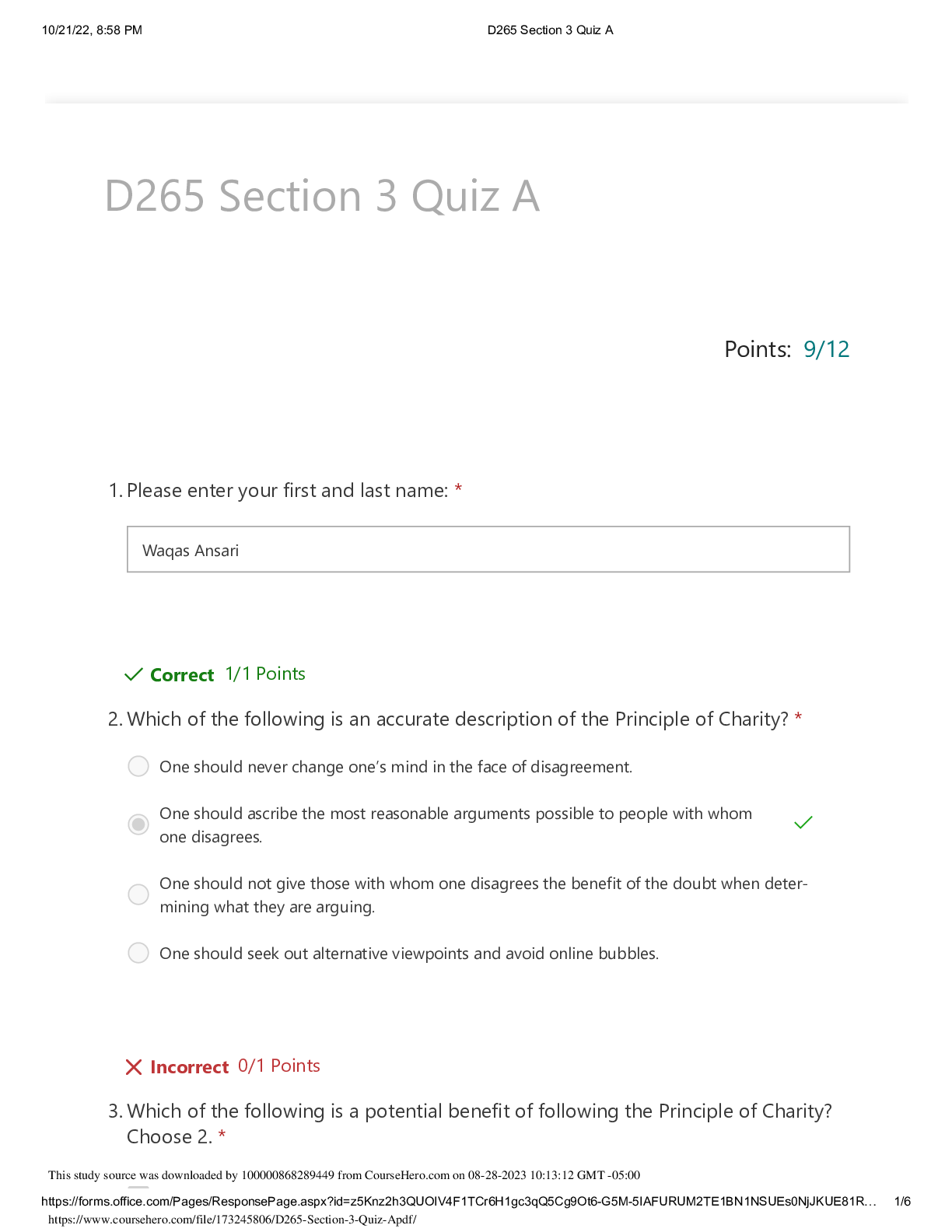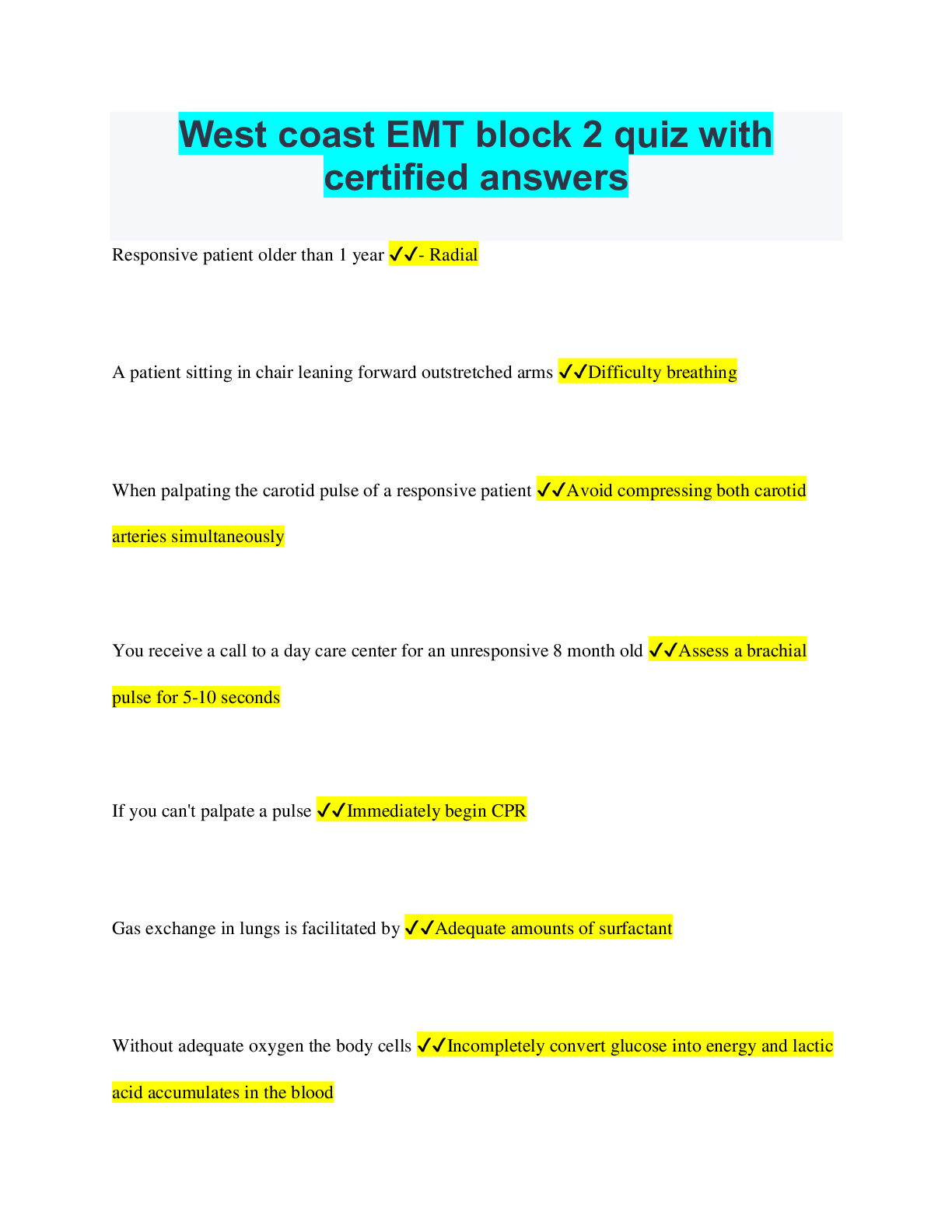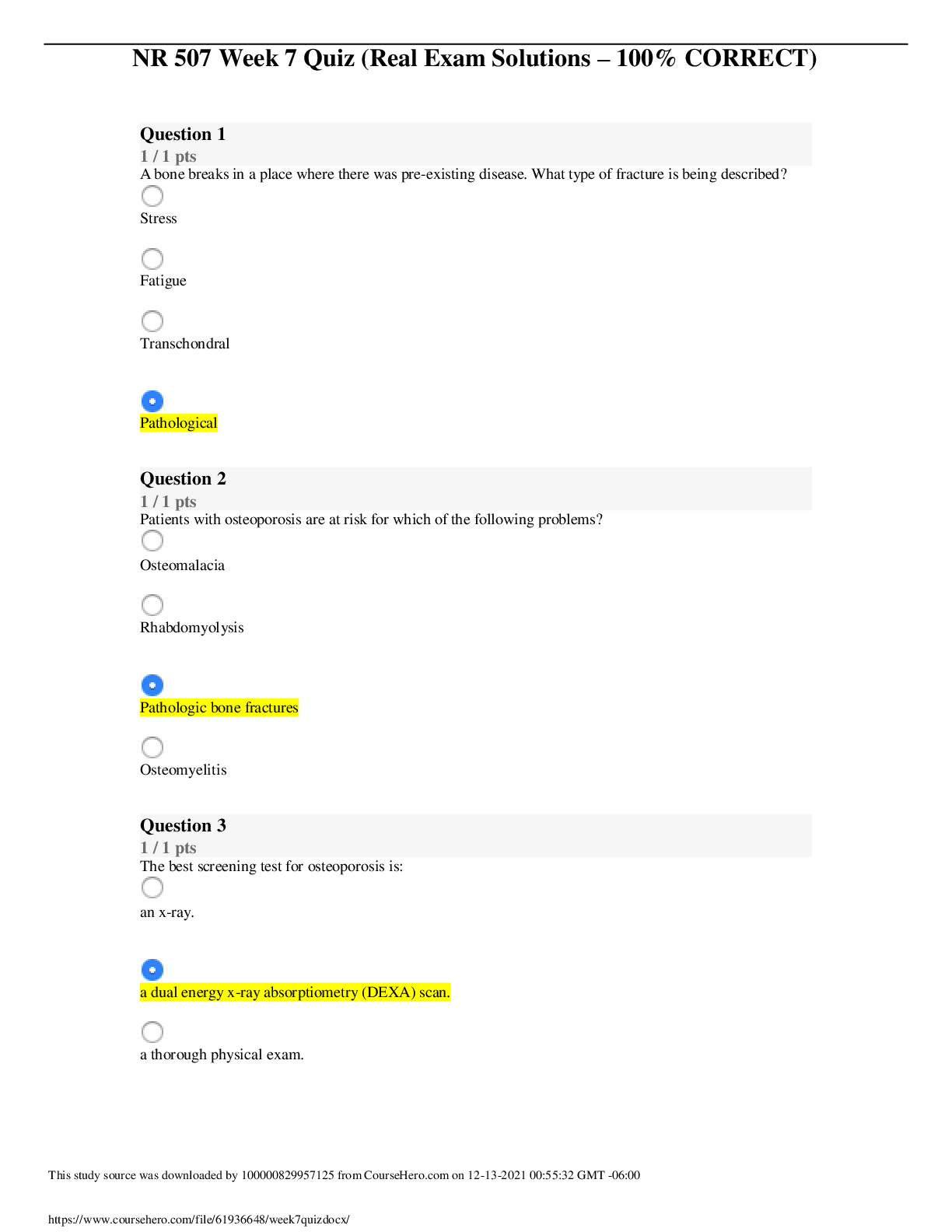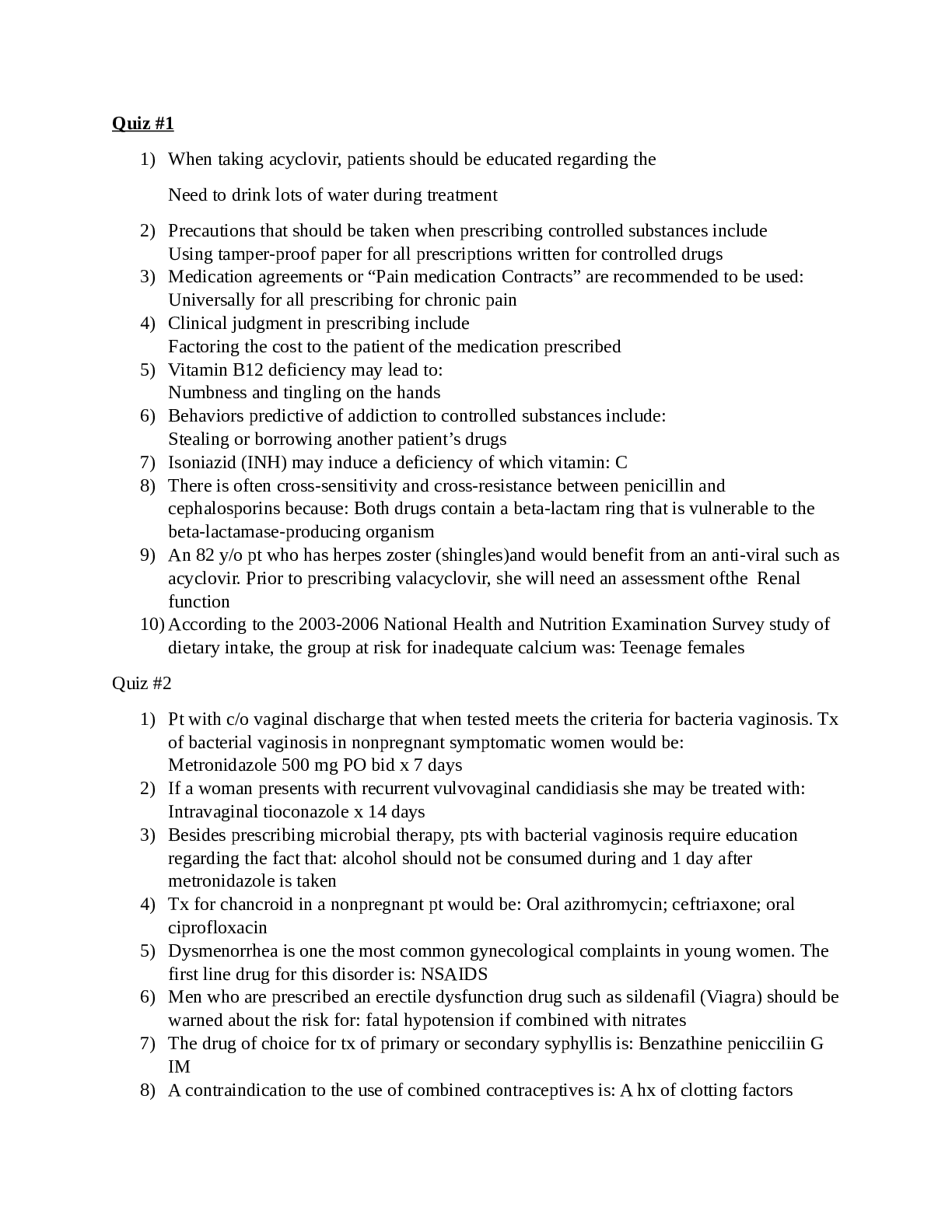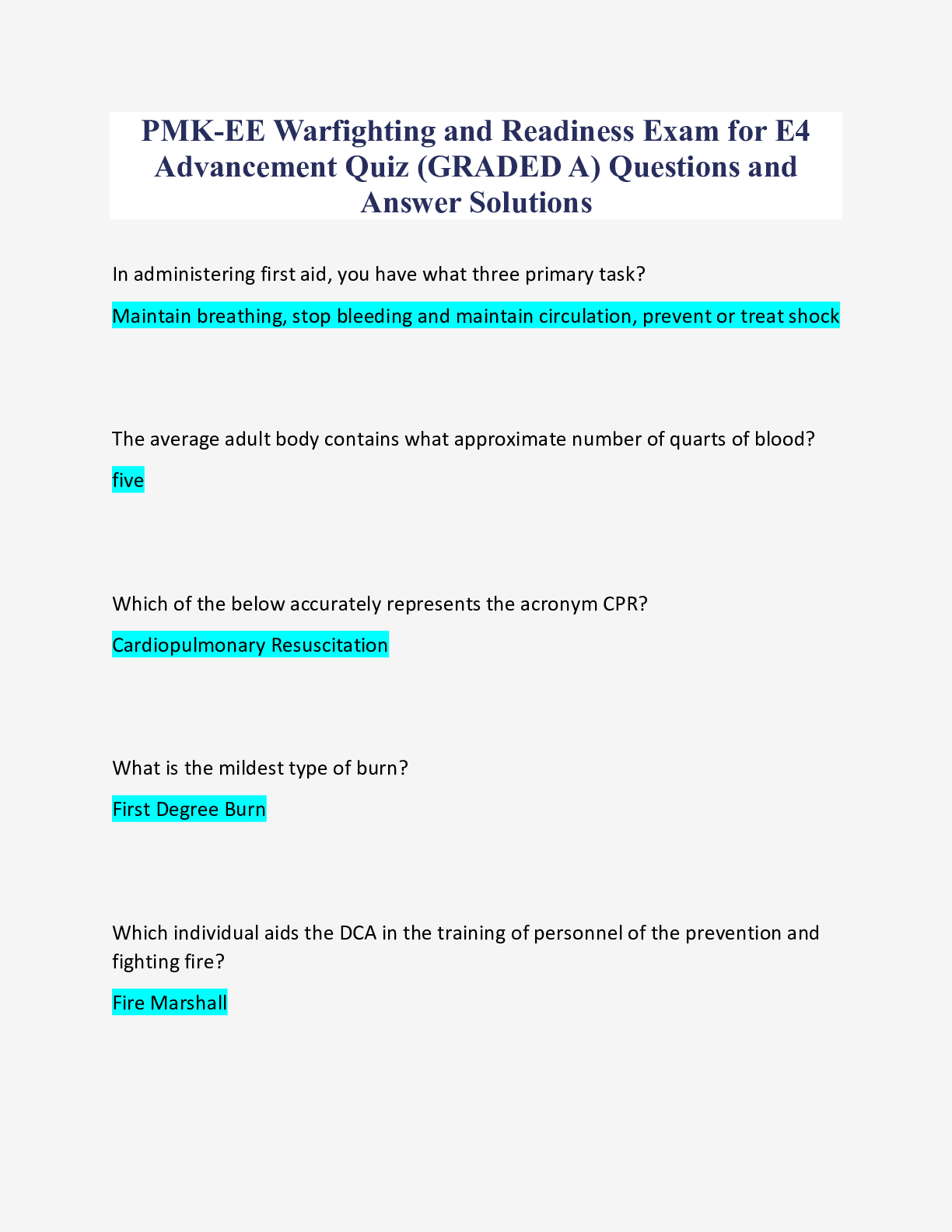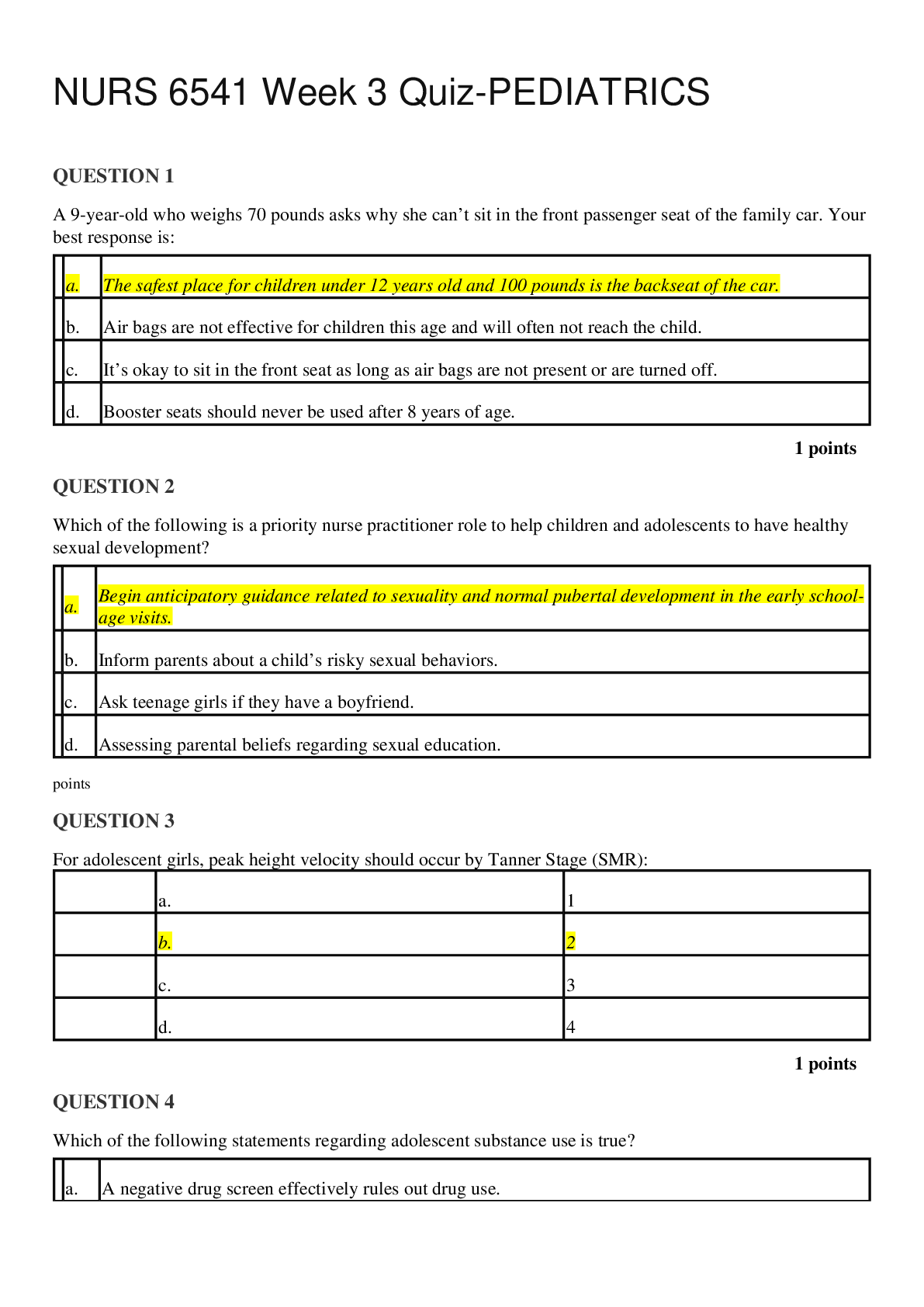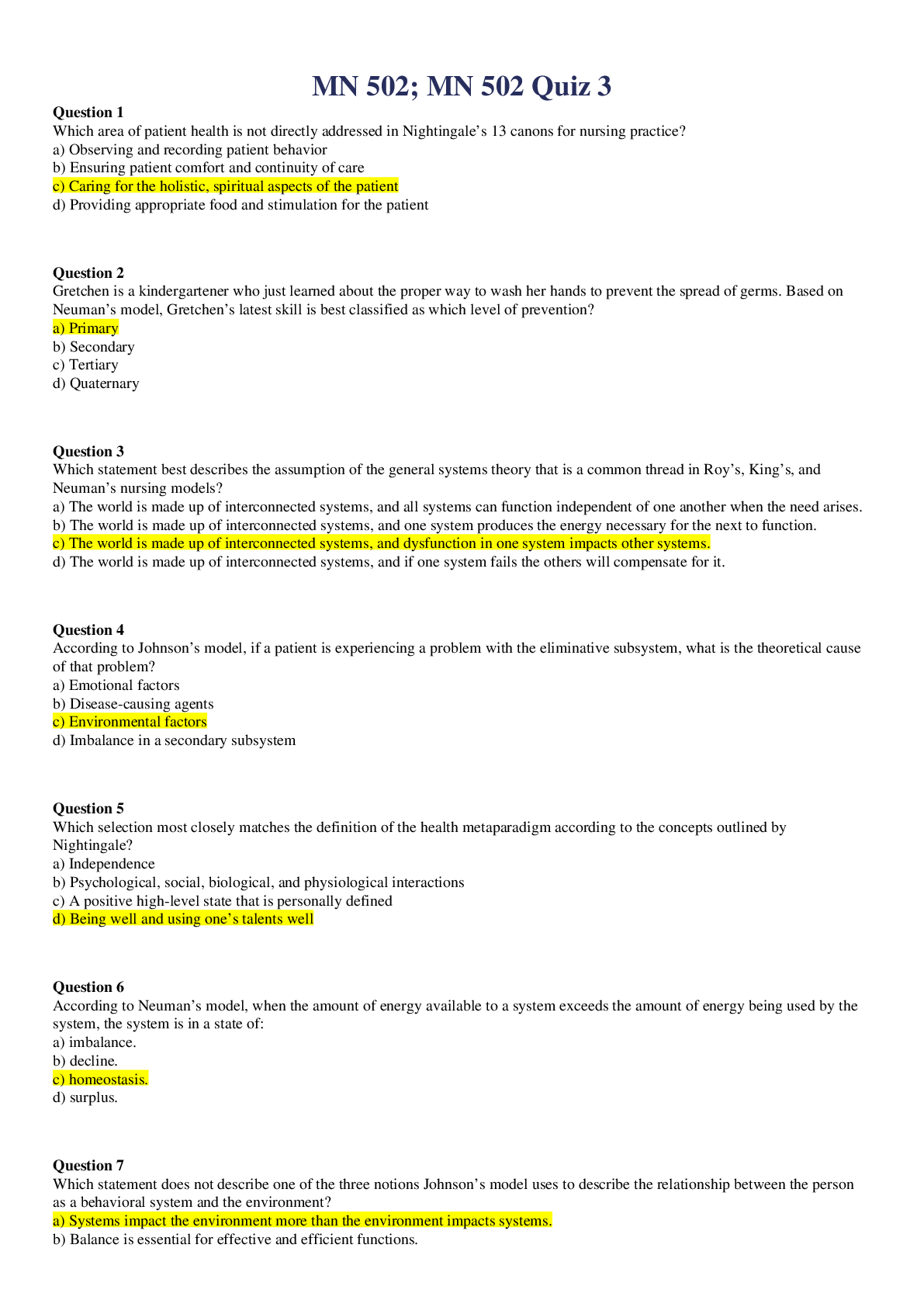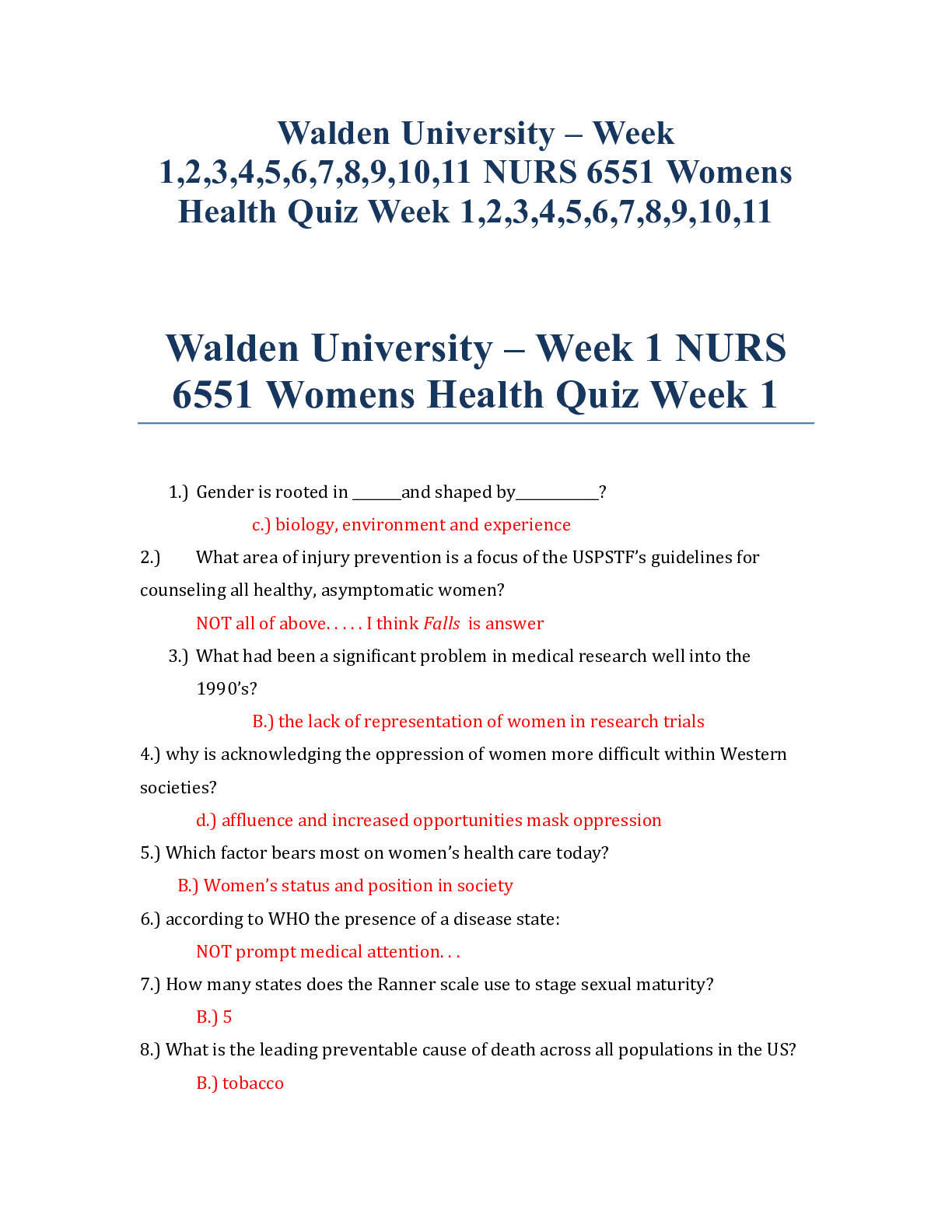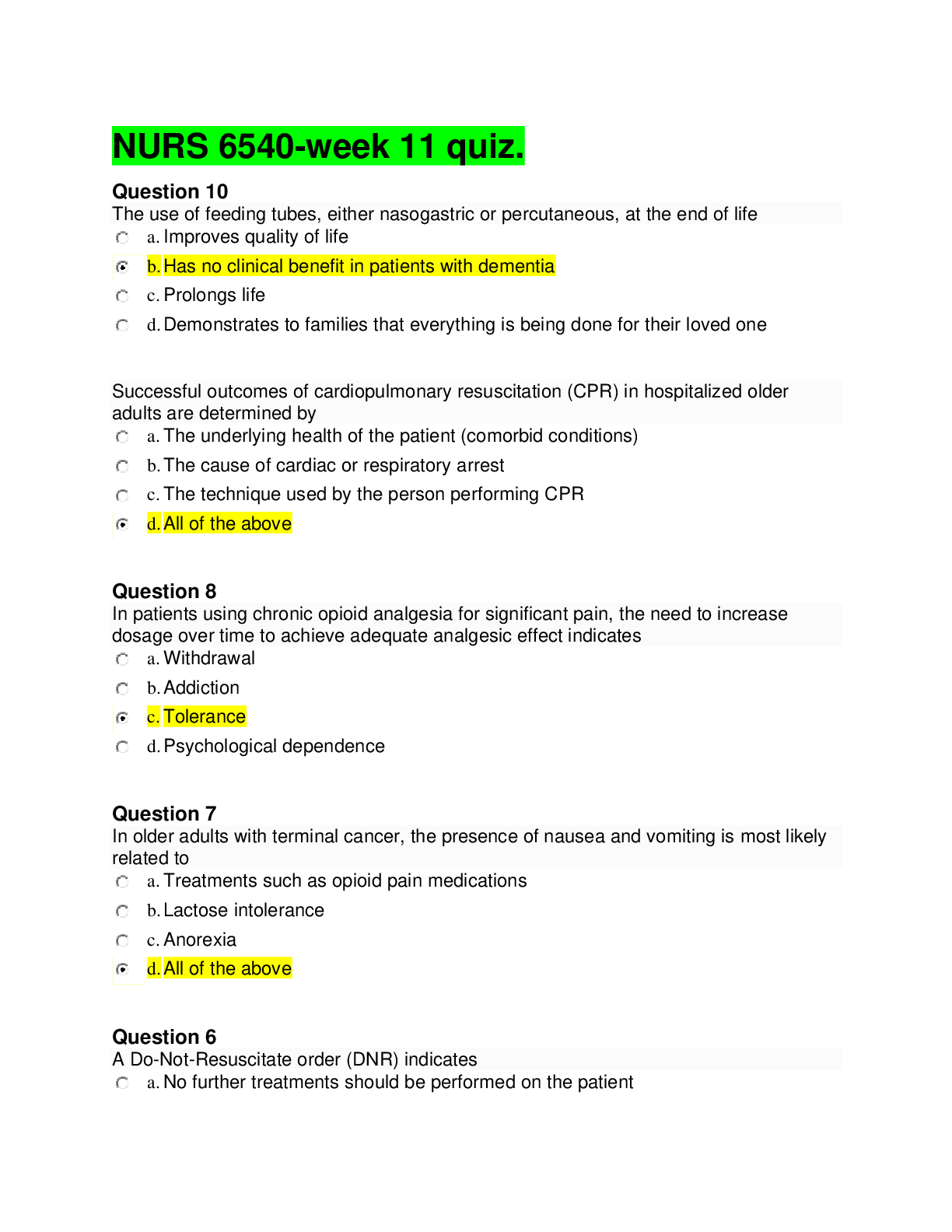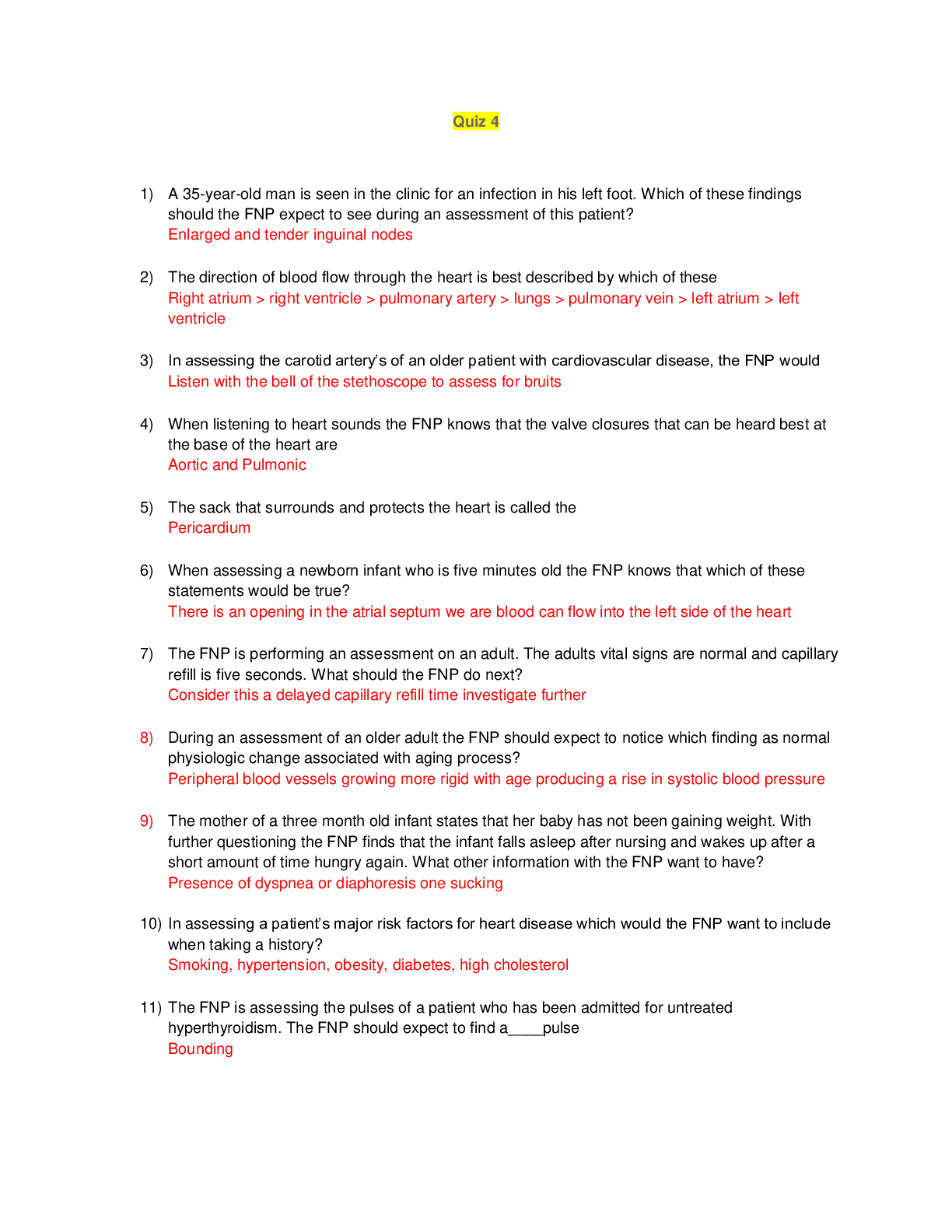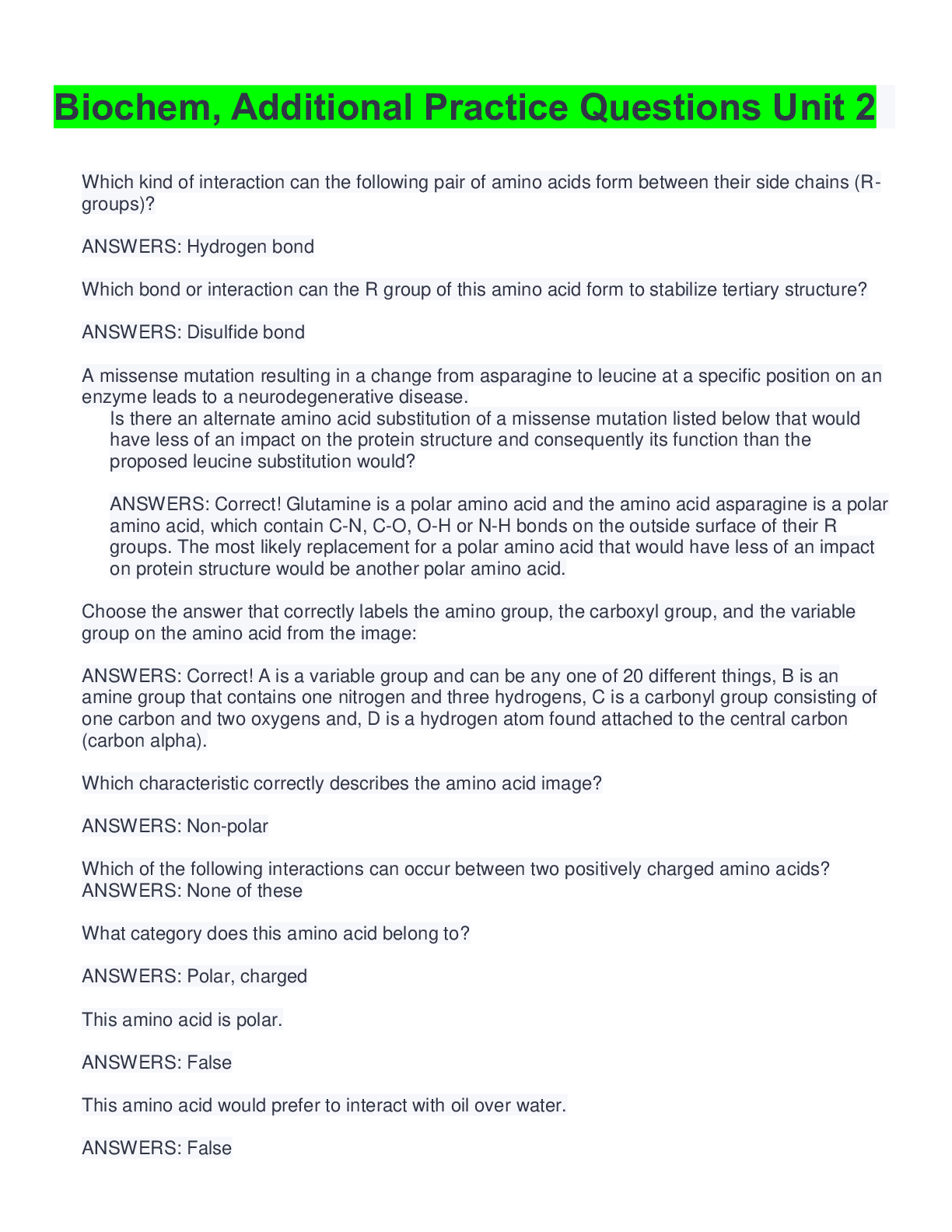Medsurge2 Pn_ Unitek Q10 EYE AND EAR DISORDERS
Document Content and Description Below
Medsurge2 Pn_ Unitek Q10 EYE AND EAR DISORDERS 1. what signs are for an otitis media infection in patients across the stage is in ages? Q1: A patient comes to the primary care clinic complaining of ... a head cold and ear pain with drainage. What should the nurse suspect this patient is experiencing? ● Acute otitis media Q2: A nurse is collecting data from an infant who has otitis media. The nurse should expect which of the following findings? ● Tugging on the affected ear lobe. 2. what some age related changes is of the ear, different anatomy within the ear and what are some expected age related changes? A 75-year-old patient has normal age-related changes in his ear. What change should NOT be considered a normal change in the aging patient ● Otitis externa Otitis Externa is also called "swimmer's ear" and this is NOT considered age related change in the ear.. Some of the age related changes are: ● Dry and wrinkled skin on the auricle ● Dry cerumen ● Hair in the ear canal 3. how to irrigate a patient’s ear, mostly bulb syringe. How are you gonna pull the ear to position everything so that you can have full access to the canal in the membrane? Q1. Which instruction should a nurse include when providing patient teaching information for a patient who will be self-administering ear drops for an ear infection? ● Tip the affected ear up and keep it in that position for several minutes after instilling the medication. Q2: What nursing action should be implemented when irrigating a patients ear? ● Use a body temperature solution and have the patient hold a basin under the ear while ● directing the solution toward the top of the canal. 4. what behavior of patient may exhibit if they have a possible hearing deficit and loss what are the behavior things that they cues they going to give you? Which patient behaviors should alert a nurse to a possible hearing deficit? (Select all that apply.) ● Watches the speaker ’s mouth. ● Gives inappropriate answers to questions. ● Fails to respond when spoken to. ● Turns the good ear to the speaker. 5. what presbycusis is? Q1: What is Presbycusis ● Hearing loss associated with age A 75-year-old patient reports having difficulty hearing in crowds but can hear just fine at home with his wife. What hearing disorder should the nurse suspect? ● Presbycusis 6. what ototoxicity is? Q1: ● ”Do you have ringing in your ears?” Q2: Ototoxicity means that a drug can damage the eighth cranial nerve or the organs of: ● hearing and balance. 7. what type of illness is often causing hearing deficit or Illnesses that cause patients be dizzy a little off-balance on their feet what are some of those infections illnesses? Q1: Sudden and persistent onset of vertigo, often accompanied by hearing loss, caused by acute inflammation or infection of the labyrinth. ● Labyrinthitis Q2: During an intake physical examination, a patient reports that he has been taking 10 aspirin tablets a day for his arthritis. What question should the nurse ask based on this information? A nurse is contributing to the plan of care for a client who has labyrinthitis. which of the A nurse is contributing to the plan of care for a client who has labyrinthitis. which of the following interventions should the nurse include in the plan? ● Monitor client's cardinal fields of vision Q3: Which patient problem would the nurse prioritize for a patient having ear surgery? ● Potential injury 8. how do you care for elderly patient in the hospital when you can tell that he has profound deafness, what exactly should you look for at the bedside to make sure that he has every advantage to hear you? A nursing report on a newly admitted patient who is profoundly deaf says that the patient is confused and difficult to assess because she does not appropriately respond to questions or sometimes fails to respond at all. What should be the first action of the oncoming nurse? ● Assess the patient to determine whether her hearing aids are in. 9. how to educate a patient about Ménière's disease, know what Ménière's disease is an how to simply explain it to a patient? What information should a nurse stress when teaching a patient with Ménière disease about managing the disorder? ● Avoiding the use of alcohol and tobacco 10. what test is used to rule out conductive hearing loss. What specific test? Q1: Rinne and Weber tests use a tuning fork to assess the: ● conduction of sound by air and bone. Q2: A nurse assessing the results of a Rinne test sees the notation of BC > AC. How should the nurse translate this result? ● Conductive hearing loss Q3: A patient undergoing a Weber test says that the sound is louder in her left ear. What should this result indicate? ● Conductive hearing loss in the left ear 11. what is a sensory neuro hearing loss is? Q1: A patient with diabetes says that he needs a hearing aid because he cannot hear well, and A patient with diabetes says that he needs a hearing aid because he cannot hear well, and everything sounds garbled and distant. What type of hearing loss should the nurse suspect? ● Sensorineural hearing loss Q2: Which statements are related to sensorineural hearing loss? Select all that apply. va ● Causes include congenital problems, noise trauma, aging, Ménière disease, ototoxicity, diabetes, and syphilis. ● A disturbance of the neural structures in the inner ear or the nerve pathways to the brain. ● Sometimes called nerve deafness. ● Patients can hear sounds but have difficulty understanding speech. 12. know all about Ménière's. what do you need to educate them about specifically to be able to better manage their Ménière's disease? What should a nurse include when educating a patient with Ménière disease? ● “Decrease your sodium intake and take your diuretic medication between attacks.” 13. how to educated patient who has just had ear surgery, when they get home there's certain instructions that they need to know about, what are some of those instructions What significant instruction should a nurse include to a patient being discharged after ear surgery? ● Avoid blowing your nose. 14. what nystagmus is? A nurse is assisting with a caloric test and notes that the specific patient response that indicates a hearing disorder is a problem in the labyrinth. Which response did the nurse witness? ● Nystagmus 15. what could cause a potential for risk for injury in a patient is receiving gentamicin (nursing interventions to care for patient is receiving gentamicin) A 94-year-old patient is receiving gentamicin sulfate (Garamycin) in a continuous intravenous (IV) infusion. The nurse adds to the nursing care plan the patient problem “Potential injury.” What nursing action should be implemented? ● Measure intake and output. 16. what kind of patient education you would provide for a patient that has vestibular disorder? When a patient has a suspected vestibular disorder, the physician orders an electronystagmography test. Which instruction should the nurse include when educating the patient about this test? ● The patient should have nothing to eat or drink (NPO) 3 hours before the test. 17. what clinical symptoms a patient will present with open angle glaucoma? ● Some ● ● ● ● ● ● A nurse is caring for a client who has diabetes mellitus and reports a gradual loss of peripheral vision. The nurse should recognize this as a manifestation of which of the following diseases? Open-angle glaucoma Others: Medical emergency, seek help quickly Headache Mild eye pain Decreased accommodation Halos seen around lights Elevated IOP (greater than 21 mm Hg: usually 22 to 32), usually bilateral 18. what clear-cut teaching needs to be provided for a patient with glaucoma. how would you explain the treatment and the disease of glaucoma?( what must they know) 19. what specific discharge teaching must they know after cataract surgery? A patient who has had surgery this morning for cataracts is now going home. What should the nurse include when providing discharge instructions? (Select all that apply.) ● Use stool softeners. ● Avoid bending over. ● Avoid lifting anything heavier than 5 lb. 20. what protective mechanisms should be reinforced with a patient after cataract surgery? Q1: a nurse at an outpatient surgery center is reinforcing discharge teaching with a client's partner following surgical removal of a cataract. which of the following information should the nurse include in the teaching? ● the client should wear dark glasses while outside. Q2: A patient has had cataract surgery. Following cataract surgery, the nurse should: ● advise the patient to sleep on the unaffected side. 21. how cataracts are diagnose, essentially what part of the eye is involve when a patient does have a cataract surgery? A nurse is collecting data from a client who has a suspected cataract. the nurse should collect data from which of the following areas to confirm the diagnosis? ● the lens of the client's eye cataracts can be diagnose by examination of the lens using an ophthalmoscope 22. what side effects of Timoptic (a beta adrenergic blocking agent that used to treat glaucoma) knows a list of the side effects? A patient with glaucoma is taking a beta-adrenergic blocking agent, timolol (Timoptic). For which potential side effect should the nurse assess the patient? ● Wheezing 23. how to ambulate a patient that is visually impaired, so you're his caregiver in the hospital how are you going to get him up and moving? How should a nurse assist a visually impaired patient to ambulate? ● Hold the visually impaired person by his or her nondominant arm and walk side by side 24. symptoms of angle closure glaucoma? A patient in the emergency department complains of severe pain in his eye and is seeing halos around lights and feeling nauseous. Which diagnosis should the nurse suspect? ● Angle-closure glaucoma 25. how to apply topical eye medication What information should a nurse include when providing information to a patient using topical eye medications? ● Pull the lower eyelid down and drop the medication into the conjunctival sac. 26. what the name of the test is called to measure intraocular pressure. what is the name of that study or test screening? Measurement of the IOP in the eye? ● Tonometry 27. differentiate closed angle glaucoma from open angle glaucoma? How does closed-angle glaucoma differ from open-angle glaucoma? ● The onset is acute. 28. what the choroid of the eye does? Q1: ● Choroid Q2: A patient who has been taking opioid medication for postoperative pain exhibits pinpoint pupils. Which anatomic portion of the eye has been affected by the medication? ● Choroid 29. what purpose the retina serves? The inner lining of the eyeball, is composed of two layers, which contains nerve cells that process visual information sent to the brain ● Retina 30. what purpose the sclera serves? The tough outer layer of the eyeball, is a white, opaque membrane except for the clear covering over the cornea. ● Sclera 31. several question about age related changes in the eye? A nurse assesses an 80-year-old patient for age-related changes to the eye. What potential changes should the nurse anticipate? (Select all that apply.) ● Decreased tear production ● Eyeball sunk deep in orbit ● Hyperopia ( it is called Presbyopia on older patient) ● Arcus senilis 32. what symptoms a patient may present if they cataract. what are some of the things they will come in and report to you? A patient reports to a home health care nurse of having cloudy vision and seeing spots and halos around lights. What should the nurse suspect based on these patient symptoms? ● Cataracts 33. how to perform eye irrigation. What is an appropriate nursing action to implement when performing eye irrigation? It is the middle layer, located between the sclera and the retina, contains connective tissue and is rich in blood vessels that deliver nourishment to the retina in the back of the eye. What is an appropriate nursing action to implement when performing eye irrigation? ● Direct the irrigating fluid from the inner canthus to the outer canthus. 34. what rods and cones are related to the eye? Which portion of the eye makes it possible for a person to see in a darkened environment? ● Rods Cones are used for daylight vision and color perception. 35. what the normal intraocular pressure is for patient that has glaucoma? Which intraocular pressure reading obtained by tonometry indicates a patient being evaluated for a visual impairment does not have glaucoma? ● 18mmHg 36. what the cause of glaucoma is? What is the cause of glaucoma? ● Increase in intraocular pressure 37. how to educate a patient about the frequency of eye exams, What is the recommended screening for eye exams? (the timeframe) What information should a nurse relay to a patient when providing education about protecting vision? ● After 40 years of age, eye examinations should be performed every 2 years. 38. what exactly part of the eye is the procedure LASIK reshaping. what part of the eye? A nurse explains that laser-assisted in situ keratomileusis (Lasik) and photorefractive keratectomy (PRK) are methods to correct refractive errors surgically. What do these procedures reshape? ● Cornea 39. What is the correct term is for a patient that actually has a vision disorder? What is the correct term to use for a patient with a vision disorder ? ● Visually impaired 40. what action you will going to take to implement a patient ability to accommodate? (PERRLA) what Accommodation mean? Q1: What actions should a nurse implement when assessing a patient’s accommodation? (Select all that apply.) ● Hold his or her finger approximately 20 inches in front of the patient’s eyes. ● Observe for pupillary constriction. ● Assess for convergence. ● Move his or her finger slowly toward the patient’s nose. Q2: ● The lens of the eye changes shape as the ciliary muscle contracts and relaxes. 41. What are some appropriate things that you can do with a hearing for a visually impaired person as far as entering, leaving the room? Which implementation is appropriate in the care plan for a visually impaired ● Announcing your presence when you enter and leave the room When being interviewed, a 50-year-old patient says that he cannot see the newspaper as well as he used to. What is the reason this patient vision has changed from near to far? [Show More]
Last updated: 10 months ago
Preview 1 out of 9 pages
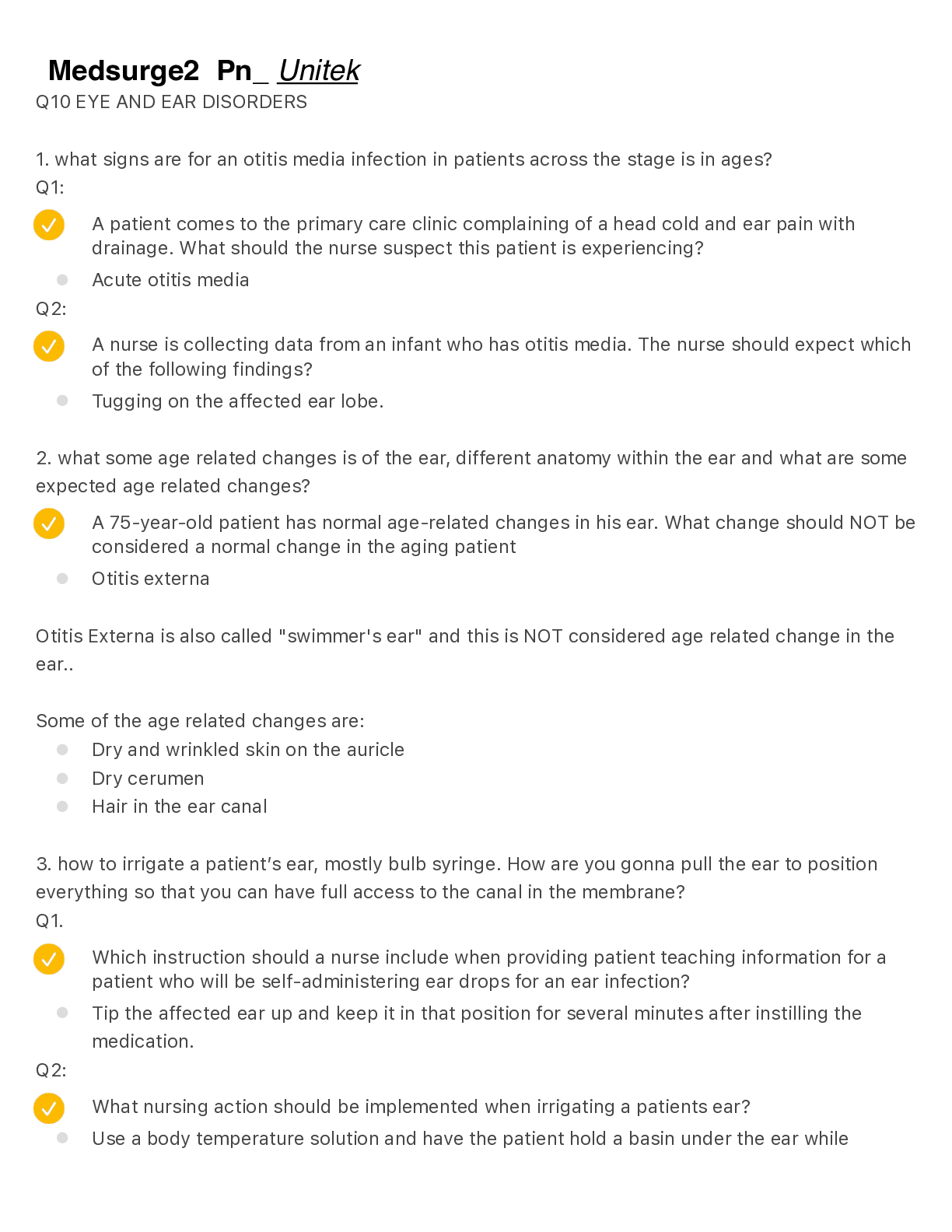
Reviews( 0 )
Document information
Connected school, study & course
About the document
Uploaded On
Apr 28, 2023
Number of pages
9
Written in
Additional information
This document has been written for:
Uploaded
Apr 28, 2023
Downloads
1
Views
60

